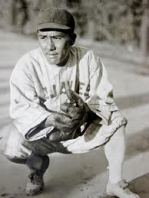10 Innings Later
10 innings later they were still trapped behind barbed-wire fences. There has been much written about baseball during internment. Leagues popped up all over the country and helped internees make it through prison in the very country to which they pledged allegiance. However, there has not been nearly enough written about one specific game. This is a game I read about years ago and could never get out of my head. The game had both a cultural impact and a defining impact. On April 18, 1945 the Tucson High School Badgers took a bus north to what is now the Gila River Indian Reservation. The Badgers were in the middle of what would be a 52-game winning streak and would eventually settle in as 10-time State Champions under legendary coach Hank Slagle. They were a team full of talent with a future “Louisville Slugger” trophy winner, and a pitcher who had finished the previous season with a 0.00 ERA. Yet, as good as they were, they were about to face perhaps their toughest challenge. The Badgers’ desitnation was not a Indian reservation half-way between Tucson in Phoenix. It was an internment camp. They were on their way to face the Butte High Eagles of the Gila River Internment Camp.Thousands of Japanese citizens had been rounded up, some separated from family members, and locked away. Irrational fear was the driving force behind the internment. We were at the height of World War II and fear of Japanese reprisals within our own country was so high, we as a nation made the irreversible mistake of imprisoning our own citizens. But there was a bright light in the darkness of our error. There was a glimmer of hope buried just beneath the surface of our fears. There was a man named Kenichi Zenimura.
Zenimura spent 55 years in professional baseball. He organized the Fresno Central California All Star Team and the Fresno Athletic Club. Considered the father of Japanese baseball in California, Zenimura played alongside the likes of Babe Ruth and Lou Gehrig.

Zenimura and his family were shipped back and forth between internment camps before finally landing in the Gila River Camp. Rather than give in to his captors, rather than fade into a life behind prison lines, Zenimura brought hope to those in the camp. With the help of his sons and other internees, Zenimura built a baseball field and organized a league. The teams Zenimura helped created were allowed to travel all over the state and sometimes even outside the state to play games. The Butte High Eagles of the Gila River Camp were a dominant team. They beat many of the Arizona High School teams by large margins and earned the respect of non-Japanese players along the way. Such respect allowed the Eagles to host Arizona’s most dominant team of the time, the Tucson Badgers. As the Badgers team unloaded from the bus, they would have been greeted by barbed-wire fences, guard towers, and they would soon realize they were entering a prison. But the Eagles were ready for them. The game was a slug-fest. Each team seemed to score at will. The Badgers realized they were facing a legitimate baseball team. Underneath the desert sun, the Butte High Eagles stopped being a prison team. They were every bit as good as the Badgers and they were playing them to the wire.

The game was tied at the end of the ninth 10-10. The Badgers failed to score in the top of the 10th, and with the eyes of the every internee of the camp on them, the Eagles looked to rally. They loaded the bases with two outs, and Zenimura’s son Kenshi stepped to the plate. The crowd held its breath in anticipation as Kenshi watched three straight balls. He was one ball away from walking and forcing in the winning run, but Badgers pitcher Joe Tully fired back-to-back strikes to run the count full. On the very next pitch, Kenshi swung an connected lining the ball to the left, past the third baseman. The Eagles had just beat the defending State Champions. The Eagles had beat a team that no one seemed able to beat. A team of internees had showed a team of high-schoolers from Tucson what it meant to believe in themselves. The game was a wonderfully exciting contest, but even more, it served to unite a community. The Tucson Badgers team realized the team that just beat them was not made up of prisoners, but of Americans. The Butte High Eagles proved that no matter the obstacle, true success is what you make it. It would have been easy to count the days and long for freedom. Many people would have just as soon sat in their barracks awaiting the end of the war as they would play a game. But they did just that. They played a game that crossed cultural lines. They played a team that defined success. And they won more than just bragging rights. While re-matches were attempted, local fears trumped entertainment and camaraderie. The two teams never played each other again, but they never forgot that game. Kenichi Zenimura wrote in part, “I can only hope that in due time the difference in opinion can be overcome and that we may be able to resume our athletic rivalry.” 10 innings later, the Butte High Eagles had to return to their prison life and the Badgers back to Tucson. But while the injustice was still there, these two teams tore down the barriers of race, war, and hate. For 10 innings, these two teams played as equals.
*Research and photos courtesy of the Nisei Baseball Research Project.
